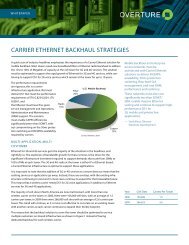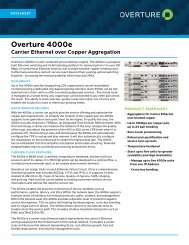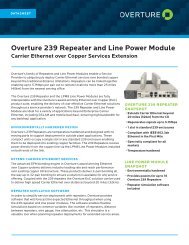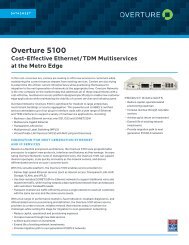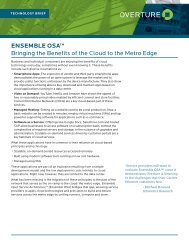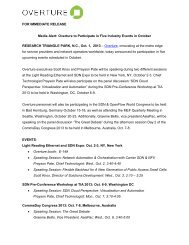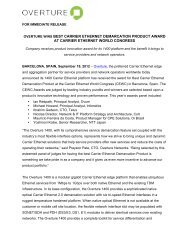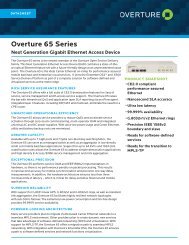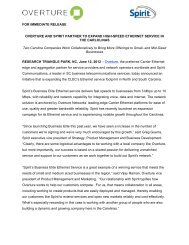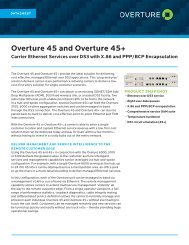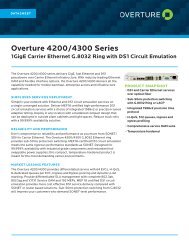G.8032 ETHERNET MULTI-NODE RING - Overture Networks
G.8032 ETHERNET MULTI-NODE RING - Overture Networks
G.8032 ETHERNET MULTI-NODE RING - Overture Networks
Create successful ePaper yourself
Turn your PDF publications into a flip-book with our unique Google optimized e-Paper software.
WHITEPAPER<strong>G.8032</strong> <strong>ETHERNET</strong> <strong>MULTI</strong>-<strong>NODE</strong> <strong>RING</strong>WHAT IS <strong>G.8032</strong>?ITU <strong>G.8032</strong> defines the multi-node ring protection architecture for native Ethernetnetworks. This standard describes the application, technology, performance characteristicsand requirements of a <strong>G.8032</strong> ring.<strong>G.8032</strong> is a technology game-changer as it provides the standards-based method ofdelivering high-performance Carrier Ethernet services over a multi-node ring with 50msprotection switching. This is important as carriers want to move away from SONET/SDHto a native Ethernet based infrastructure, but do not want to give up standards-based50ms switching and 99.999% reliability.ITU <strong>G.8032</strong> is a technology gamechanger– delivering the cost andEthernet services advantages ofa Carrier Ethernet infrastructurewith standards-based 50msprotection switching.— Scott Knox, DirectorSolutions DevelopmentWHY CARRIERS PREFER <strong>G.8032</strong>Carriers and customers prefer <strong>G.8032</strong> because it is a standards-based solution that meetstheir operational and service requirements.Advantages of <strong>G.8032</strong> include:• Multi-node ring architecture increases fiber efficiency compared to a dedicated fiber pairfor every endpoint• 50ms protection switching• Standards based – leverage best of breed in the marketplace instead of being locked intoa single vendor.• Deterministic – Performance doesn’t change depending on ring loading or fault scenario• No complicated design rules• No hop-by-hop provisioning• Doesn’t require a complicated control plane• Uses Y.1731 for failure detectionHOW <strong>G.8032</strong> WORKS<strong>G.8032</strong> uses standard 802.1 MAC, OAM frames and 802.1Q tagging. Using standardtechnology components reduces the cost and complexity of the solution, and makesinteroperability with other existing Ethernet solutions easier.Because <strong>G.8032</strong> is specifically developed for use in a ring architecture, a procedure toprevent loops is very-straightforward — only one port on the ring needs to be blocked.For this reason, Spanning Tree Protocol is not required. Standard Forwarding Database(FDB) MAC learning, forwarding and flush mechanisms are used inside the ring.Monitoring of ring connectivity can leverage both physical layer failure detection as well asY.1731 Continuity Check Messages (CCM) messages. To support 50ms protection switching,CCM messages are sent every 3.3ms. If three CCM messages are not received (a total of10ms), the ring declares a ring fault and initiates ring switching.The <strong>G.8032</strong> standard requires that a ring with up to 1,200km of fiber and 16 nodes switchwithin 50ms, consistent with SONET/SDH design criteria. The standard allows more than16 nodes, but depending on the amount of fiber delay above 1,200km and number ofnodes above 16 added to the ring, the protection switching time could exceed 50ms.
To see how a ring operates in normal mode, reacts to a fault, and then restores after thefault is repaired, refer to the figures and discussion below.In Figure 1, an example four-node ring is shown. One node is provisioned as the RingProtection Link (RPL) owner. The function of the RPL owner is to block one link in normaloperation, and to unblock that link if a failure is signaled. Any node on the ring can be provisionedas the RPL owner; in this example, Node-A is provisioned as the RPL owner. Eachlink is monitored by its two adjacent nodes, sending Y.1731 CCM messages every 3.3ms.RPL owner blocks onelink in normal modeto prevent loops.BHubA<strong>G.8032</strong> RingCEthernet IPNetworkDFigure 1: <strong>G.8032</strong> Ring, Normal StateIn Figure 2, a fiber cut occurs between nodes A and D.1. Nodes A and D are sending Y.1731 CCM messages every 3.3ms, detect that threemessages have been2. lost and signal the link fault to the ring members with a Ring-APS switch requestmessage. A hold-off3. timer for switching can be provisioned if protection at other layers is also involved(default for hold-off is 0, to enable immediate switching).4. The RPL owner unblocks the RPL and notifies the ring the RPL link is unblocked.5. All nodes perform a FDB flush and continue to forward packets based on new ringtopology with the6. RPL link unblocked. The entire process takes less than 50ms.RPL owner unblockslink, flows switchXaround failureBHubA<strong>G.8032</strong> RingEthernet IPNetworkCXFiber cutDFigure 2: <strong>G.8032</strong> Ring, Ring Fault State2
Once the fiber cut is repaired, the ring is ready to return to the normal state.1. Nodes A and D which are adjacent to the repaired fiber resume successful Y.1731 CCMcommunication over the repaired link and determine the link is back in service.2. Nodes A and D will notify the ring nodes that the link is successfully restored with aRing-APS-NR message.3. The RPL owner starts Wait-to-Restore (WTR) timer to prevent premature ring restoralif there are intermittent failures.4. Once WTR timer has expired, RPL owner blocks RPL link and notifies ring nodes toperform FDB flush.5. All nodes perform a FDB flush and continue to forward packets based on new ringtopology with the6. RPL link returned to normal state (blocked). The entire process takes less than 50ms.COMPETING TECHNOLOGIESThere are other multi-node protection solutions available which have some of the advantages of <strong>G.8032</strong>, but there are key differences to be considered when making atechnology choice.SPANNING TREE PROTOCOLSpanning Tree Protocol (STP) is one of the oldest solutions in the market. STP does notprovide protection by itself. STP is an algorithm and protocol to discover network topology,detect loops in the network and block ports to prevent loops. STP can be used in conjunctionwith a switching logic and mechanism to restore service when there is a network fault.The biggest concern with STP is its slow resolution time. STP was designed for best-effortsingle enterprise networks. It is typical to take from 30 seconds to 2 minutes to completean STP topology change in the network. As the network grows, the time for topologyresolution increases.RAPID SPANNING TREE PROTOCOLRapid Spanning Tree Protocol (RSTP) is an update to STP which as its name implies,increases the speed of network topology resolution by introducing new concepts to boundthe size of the network domain and speed convergence time. RSTP reduces networkresolution to low seconds, with 6 seconds being the default. There are network configurationsthat can realize 50ms switching utilizing RSTP, however there are a number of designand configuration constraints to realizing fast switching. Another customer concern is thatdepending on the nature of the network configuration, loading and failure scenario, theperformance of RSTP can vary.RESILIENT PACKET <strong>RING</strong>Resilient Packet Ring (RPR) enables a ring topology, failure detection and recovery fromfiber cuts and node failures. RPR uses Ethernet switching and dual counter-rotatingfiber-optic rings called ringlets to provide network resiliency.The RPR MAC protocol is different from the ordinary Ethernet. RPR also defines an RPRspecific OAM protocol, which is used for topology discovery, fault detection, performancedetection, and fairness control. Because RPR uses a different MAC header it is not directlycompatible with standard Ethernet. Also, the specialized OAM requires extra developmentand processing vs. using mainstream Ethernet OAM such as 802.1ag or Y.1731. RPRsupports only 3 classes of service. Customers and carriers deploying Carrier Ethernetneed to engineer for up to 8 classes of service.PROVIDER BACKBONE BRIDGE TRAFFIC ENGINEE<strong>RING</strong>Provider Backbone Bridge Traffic Engineering (PBB-TE) uses the MAC-in-MAC taggingconcepts of 802.1ah Provider Backbone Bridges for handling tag address management.A primary difference between PBB and PBB-TE is the ‘traffic engineering’ component.PBB-TE turns off the flooding and discovery aspects of PBB which can autonomously3



